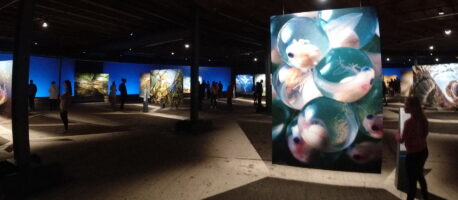
221105. Last Wednesday, the Q1 Advanced Biology Course and the Q2 students went on an excursion to the Oberhausen Gasometer, an impressive industrial monument at 117 m high and almost 70 m in diameter, which used to serve as a gas storage facility for the surrounding steel mills, but – as Europe’s highest exhibition hall – it is now used for events.
Together with Ms Storz and Dr. O, the students visited the exhibition “The Fragile Paradise“, which shows the beauty of nature and the influence of man on his environment over three floors. The exhibition takes visitors on a visual journey through the turbulent climatic history of our earth and impressively shows pictures by award-winning photographers and videos on how animals and plants and their habitats and ecosystems have changed in the age of the Anthropocene (Gasometer). Thematically, the exhibition not only ties in with the biology curriculum of the two upper grades, but also with current socio-political issues.
The two lower floors show large-format photos of endangered animal and plant species, their habitats and the glaring and diverse consequences of man’s irresponsible and profit-oriented treatment of nature – climate change, deforestation, the overexploitation of animals, plants and their habitats, environmental pollution, especially of the oceans, and the effects of industrial agriculture. However, approaches to solutions are also shown that give more or less hope of still getting a grip on the problems presented.
Finally, the 3rd floor showed the highlight of the exhibition – a huge, monumental balloon made of fabric, 20 m in diameter, onto which satellite data of natural and man-made processes on earth were projected. From an astronaut’s perspective, continents, clouds, ocean currents and ice movements in the day-night rhythm and over the course of the seasons can be seen, as well as human activities such as shipping and air traffic and light pollution.
“It was particularly impressive and at the same time upsetting that we were confronted with the consequences of the exploitation of our planet, consumption and overpopulation, and that everyone could think for themselves about the influence we ourselves have on development and under what circumstances we want to and can (survive) in the future.” The students were asked to choose a particularly touching picture and to write an essay on the topic to work out the causes of the endangerment and to look for possible solutions. Selected essays will later be displayed in our school to provide thought-provoking impulses for other students who were unable to visit the exhibition.
A ride in the glass lift up to the roof of the Gasometer at a height of 100 m enabled another unusual view of our “blue planet” that will certainly remain in memory. A visit to the exhibition in the Gasometer is highly recommended!









